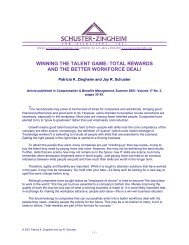competencies and competency models - Schuster-Zingheim and ...
competencies and competency models - Schuster-Zingheim and ...
competencies and competency models - Schuster-Zingheim and ...
Create successful ePaper yourself
Turn your PDF publications into a flip-book with our unique Google optimized e-Paper software.
A potential inequity in this battle is that the selection of "unique" <strong>competencies</strong> is extremely difficult,<br />
<strong>and</strong> the purchase of a dictionary of ready-to-use <strong>competencies</strong> is very easy. There is no "marketing effort"<br />
supporting the position of unique <strong>competencies</strong> that provide differential advantage. On the other h<strong>and</strong>,<br />
marketing of the dictionary can be actuated by a powerful sales force that may not provide a balanced<br />
view of the available alternatives.<br />
Given the alternative sources of <strong>competencies</strong> <strong>and</strong> <strong>competency</strong> <strong>models</strong>, the actual strategies<br />
adopted by organizations will probably result from a combination of the following factors <strong>and</strong> beliefs:<br />
• Competencies are common sense, specific <strong>competencies</strong> are not critical <strong>and</strong> an ultimate<br />
<strong>competency</strong> model exists. These three reasons may be parts of a single reason: Many<br />
organizations may need a starting place for building competence because they lack ability to<br />
deploy competence strategically. This makes sense if companies plan to use an initial set of<br />
ultimate <strong>competencies</strong> <strong>and</strong> will eventually evolve their <strong>competency</strong> model into one that is unique<br />
once they have instituted <strong>competency</strong> development at the rudimentary level. This would clearly<br />
be a catch-up strategy, but it may prove practical <strong>and</strong> workable if it is not essential to deliver<br />
"unique" <strong>competencies</strong> from the start. This is consistent with a nimble view of compensation that<br />
suggests getting started with a pay transition process <strong>and</strong> fine-tuning as the process unfolds<br />
(Ledford 1995a).<br />
• Competencies are sold; <strong>competencies</strong> are copied from role <strong>models</strong>. Buying <strong>and</strong> copying<br />
<strong>competencies</strong> are clearly reasons for why organizations deploy similar <strong>models</strong>. While this does<br />
not result in the delivery of unique <strong>competencies</strong>, it does get organizations going on the<br />
<strong>competency</strong> deployment process. To a great extent, the ability of an organization to replace<br />
purchased or copied <strong>competencies</strong> with their own <strong>competencies</strong>, definitions or interpretations<br />
eventually will determine which firms gain unique advantage from <strong>competencies</strong> <strong>and</strong> <strong>competency</strong><br />
<strong>models</strong>. From the 1960s through the 1990s, companies have had great difficulty breaking free of<br />
one-size-fits-all job evaluation <strong>models</strong> once they were implemented. If the same proves true of<br />
<strong>competencies</strong> <strong>and</strong> <strong>competency</strong> <strong>models</strong>, those that buy or copy may be adapting practices that<br />
were recently ab<strong>and</strong>oned by others in the search for unique advantage. The study of best<br />
practices may measure what was rather than what will be for future-focused companies.<br />
• Organizations share challenges/shortcomings. Shoring up shortcomings to address challenges is<br />
one reason organizations seek advantage through the deployment of <strong>competencies</strong>, not only in<br />
matters of pay but also in development, selection, succession, performance management <strong>and</strong><br />
other aspects of human resources management. Organizations that diagnose their situations <strong>and</strong><br />
determine the match between their challenges <strong>and</strong> their shortcomings may have common ground<br />
in the selection of <strong>competencies</strong>. For example, the past decade has provided ample evidence<br />
that concern for customers is both a challenge <strong>and</strong> a shortcoming for most companies.<br />
Companies that match challenges, shortcomings <strong>and</strong> solutions early are most likely to deploy<br />
future oriented <strong>competencies</strong> effectively.<br />
• Organizations capitalize on demonstrated strengths. Organizations may want to emphasize even<br />
more strongly what they do better than their competitors to provide customer value. For example,<br />
3M Corp. may want to emphasize innovation because it already has a competitive advantage in<br />
that area. Walt Disney Co. may want more <strong>and</strong> more "magic" because it clearly "outmagics" its<br />
present competitors. Wal-Mart Stores Inc. may believe continuing to buck conventional wisdom in<br />
retailing is the way to keep its advantage. This view suggests that advantage often comes from<br />
more of the same good moves rather than introducing new moves.<br />
• Organizations gain advantage through execution. This option is a potential partner with any of the<br />
other options, <strong>and</strong> it is the most powerful <strong>and</strong> promising. Few companies are able to expend<br />
extensive time <strong>and</strong> effort studying <strong>and</strong> overstudying needed <strong>competencies</strong> because they are<br />
deficient in many areas of <strong>competency</strong> pursuit. While organizations share strategies, advantage<br />
© 1996 Patricia K. <strong>Zingheim</strong>, Gerald L. Ledford Jr. <strong>and</strong> Jay R. <strong>Schuster</strong><br />
- 6 -



